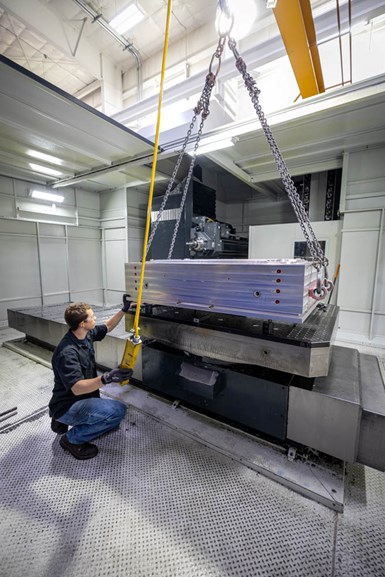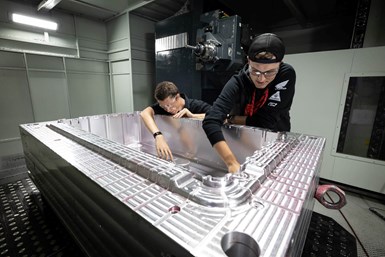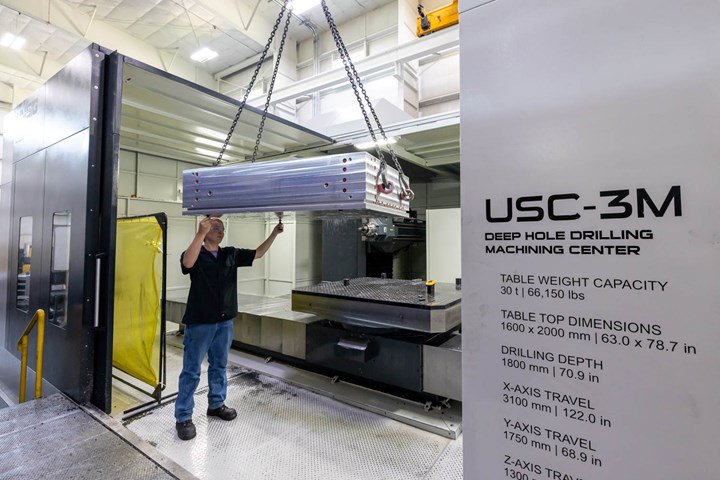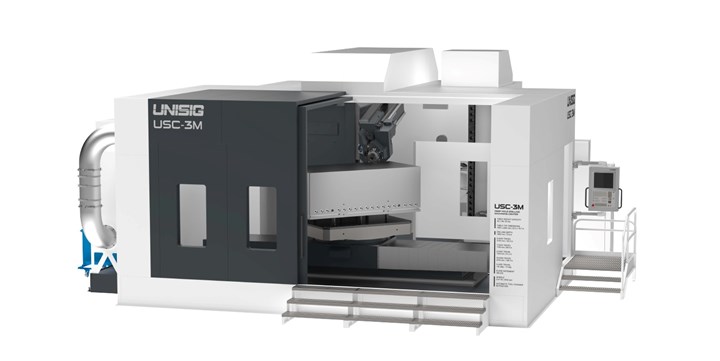
MSI Mold Builders identified a bottleneck at the very start of its manufacturing process where it squared mold blocks and drilled and tapped eye-bolt holes to rapidly and safely move large blocks around the floor. This typically involved six setups on two different machines and each setup took 30-60 minutes. Photo Credit: MSI Mold Builders/Creative Technology Corp.
MSI Mold Builders (MSI) of Cedar Rapids, Iowa, and Greenville, South Carolina, specializes in designing and building large-tonnage prototype and production molds for use in the medical, packaging, agricultural, truck, appliance, power sports, heavy equipment, aviation and materials handling segments. For over 20 years, MSI has been firmly committed to lean manufacturing, applying Six Sigma and 5S principles to identify choke points, reduce waste, improve safety and quality, and increase productivity and customer satisfaction. A few years ago, the Cedar Rapids team identified the first step in their mold building process as a bottleneck, preventing the company from reducing lead times and increasing capacity.
Reduce Setup, Boost Productivity

MSI Mold Builders specializes in design and construction of large-tonnage prototype and production molds sized to fit presses ranging from 250 to 6,600 tons. The 51-year-old company employs a team of 90 between its Cedar Rapids, Iowa, and Greenville, South Carolina, facilities. Photo credit: MSI Mold Builders/Creative Technology Corp.
“The core and cavity sides of our molds tend to be very large blocks that average 8,000 pounds [3,629 kilograms],” explains Chris Waterbury, MSI Cedar Rapids production manager. “Given their size and weight, these blocks are difficult to handle, so our first step is to square the blocks and then install eye bolts, which allows us to move blocks through our manufacturing process quickly and safely.” Historically, blocks would first go into a horizontal boring mill to be squared on all four sides; then, they’d be moved to the gundrill to have the eye-bolt holes drilled. This process typically required six setups between the two machines, and each setup typically took 30-60 minutes. “What we wanted was to find a single machine where we could both square our blocks and drill and tap for eye bolts — ideally using fewer setups,” he says.
Featured Content
“Roger Klouda, our president, is always looking for new and innovative ways to improve our operations,” adds Steve Hoeger, MSI COO. “As MSI continues to grow, we need to keep improving our operating efficiencies. So, as luck would have it, at a show, Roger saw a new Unisig product that he thought would help us shorten lead times, increase capacity, and improve safety and quality — an all-in-one machine that was specifically designed for moldmaking and unique in the size blocks it could handle.”
The machine in question was part of the USC-M series, a group of machining centers from Unisig that had indeed been designed to meet the needs of the moldmaking industry and were able to both mill and deep-hole drill. Two of the four machines in this family have a universal spindle that both mills and gundrills, while the other four have two spindles — one that mills and the other that gundrills and produces deep holes using the BTA process, which is even faster than gundrilling.
The model that interested the MSI team was the USC-3M, a 3+2 axis machine that can rough mill but also gundrill to a depth of 71 inches/180 centimeters on each side, as well as drill angled holes at +30° and -15°, which provides more flexibility where waterlines are placed, helping moldmakers improve cooling and reduce cycle times for their molder customers. Additionally, the machine has a rotating table that is 63 × 78 inches/160 × 198 centimeters and can hold a block of up to 66,150 pounds/30,005 kilograms while providing travel of 122 inches/310 centimeters in the X-axis, 69 inches/175 centimeters in the Y-axis and 51 inches/130 centimeters in the Z-axis.
“We were excited about this machine because it looked like it would do exactly what we needed at the front-end of our process and greatly improve lead times,” says Waterbury. The team visited Unisig headquarters outside Milwaukee to learn more.
“We’ve absolutely seen an impact on our process. Conservatively, that Unisig saves us six to 10 hours of setup time in the first step of our operation.”

Since installing the Unisig USC-3M milling/drilling center, MSI estimates it saves six to 10 hours of setup time at the start of its mold building process, which equates to 10-15% of total machining time. This savings has translated into the ability to produce 5% more molds annually. Photo credit: MSI Mold Builders/Creative Technology Corp.
Experts in Deep-Hole Drilling
Unisig was founded in Elgin, Illinois, in 1981 and relocated to Menomonee Falls under its current ownership in 1995. In 2011, Unisig set up Unisig GmbH in Germany to better serve European customers. The company offers complete deep-hole drilling systems, including machines, tools and automation — all designed and built in the U.S. and serviced by a global sales and service organization. Throughout its history, Unisig has built expertise in deep-hole drilling, which is illustrated by the breadth of equipment it produces — from machines that can drill delicate 1-millimeter/0.040-inch-diameter holes in titanium medical components, to machines that can drill 500-millimeter/20-inch-diameter holes over 10 meters/30 feet deep in massive, high-strength steel forgings for the power industry.

MSI has firmly committed to lean manufacturing for over two decades, applying Six Sigma and 5S principles to identify choke points, reduce waste, improve safety and quality, and increase productivity and customer satisfaction. Photo credit: MSI Mold Builders/Creative Technology Corp.
“Our purpose is to be the answer to any deep-hole drilling problem in any industry anywhere in the world,” explains Anthony Fettig, Unisig CEO, who started as an engineer at the company in 1994. “To accomplish that, we listen carefully to our customers to understand what they need, then we build a product in line with their vision. Plus, we invest in ourselves to keep expanding and growing this market organically.”
For example, he recalls that no one had ever heard of the company when Unisig first considered getting into the moldmaking industry. However, after speaking with mold builders for several years, Unisig recognized that there was pent-up demand for a machine that could mill and drill well. “What struck us was that existing options were underpowered and couldn’t offer aggressive CNC machining,” continues Fettig. “We knew our priority was to engineer a machine that could mill aggressively and still had enough power and sophistication to drill fast, yet also had the accuracy that would enable you to trust the machine. In addition, our goal was to help mold builders get more work done with less setup so they could cut calendar days off their production schedule. That, in turn, would enable them to be more flexible on engineering changes by not having to reprocess molds multiple times as they moved through production.”
Unisig introduced its first USC-M series machines in 2006 — the M is for mold building — and introduced its first models (the -3M and smaller -2M) with universal spindles that could mill and drill in 2018 when indexable gundrills became viable. “We have a bias toward clean, simple-to-use and very capable machines because if you get the foundational things right, then you have a competitive advantage,” adds Fettig. “There’s a reason our headstock weighs what it does and why we engineer powertrain dynamics and frame stiffness/rigidity the way we do, as these aspects are really important to get right for effective milling. Our USC-3M has a 30-ton table capacity. It’s a very big, strong machine whose weight capacity is much higher than a typical horizontal boring or milling machine. However, we felt it needed that, as well as very good reach and very high volumetric accuracy, to open up opportunities for our customers to process molds differently. Some people think we overbuild our machines, but we believe we’re taking our massive experience in deep-hole drilling and using it to futureproof our products against changes.”
Fettig recounts his deep respect for the mold building industry and how discussions with mold building customers helped Unisig improve its own manufacturing operations. “Moldmakers are very good at machining. Their influence while we developed the USC-M series inspired the adoption of technologies in our plant, such as modular fixturing, offline tool setup and full process simulation, which helped us be more productive. They totally changed the way we think about machining, and what we learned from them made us a better company.”
Reduced Setup Pays Off
MSI ordered its new USC-3M model with a standard 60-position toolchanger, Heidenhain controllers and glass scales standard; no additional customization was added. The machine has been operating since February 2021, and the MSI team has already seen marked improvements in productivity.
For starters, every new mold that passed through the Cedar Rapids facility previously spent time on the company’s single gundrill. Now, 50% of that volume — all the biggest mold blocks — has been diverted to the Unisig, where blocks are squared and eye-bolt holes are drilled and tapped. As a result, MSI estimates that all the setup time it previously expended to machine each side of the block and to move blocks back and forth from one machine to another at the start of its process has been reduced to a single setup on the Unisig, saving 10-15% of the total mold machining time, which has enabled MSI to increase its overall capacity by a minimum of 5% each year.

MSI purchased this Unisig USC-3M, a 3+2 axis machine that can rough mill and gundrill to a depth of 71 inches/180 centimeters on each side, as well as drill angled holes that provide more flexibility where waterlines are placed, helping molders cool and eject parts faster. Photo credit: Unisig
“We’ve absolutely seen an impact on our process,” says Waterbury. “Conservatively, that Unisig saves us six to 10 hours of setup time in the first step of our operation. That helps reduce errors and improve quality, plus it’s much safer not moving those big blocks around multiple times. The machine’s rotating table is a big benefit, and its ability to handle big blocks and drill to depths of 71 inches per side without changing setups is a real time saver. We also really like its large toolchanger. It all adds up to fewer setups, and its size and capabilities are really good fits with what we do here.”
“We hadn’t specifically been looking for a particular kind of machine,” adds Hoeger. “Rather, we just wanted to find ways to multitask to increase our business capacity and solve the problem of how to get our biggest blocks ready to go to the next step. This machine has done all that for us, and we’re very happy with its capabilities. It’s a multifaceted machine that solves our bottleneck and meets our needs. Plus, we really like that Unisig is close by in Milwaukee if we have a problem or need a part.”
Why should a moldmaker considering a hybrid milling/drilling machine purchase a Unisig? “We mill better, we drill faster, our volumetric accuracy will enable them to trust the machine, and we have the reach and travel to enable them to hit all four sides of the block if they want so they can work from the center of the table, not the corners,” says Fettig. “Also, because we listen to our customers and have vast experience in deep-hole drilling that no one else can touch.”
RELATED CONTENT
-
3D Printing Enables Better Coolant Delivery in Milling Operations
Just like 3D printing enabled conformal cooling channels in molds, additive manufacturing is now being used to optimize coolant delivery in cutting tools.
-
End Mills, Drills, Inserts and More for Mold Building Needs
This list of cutting tool-related products that MMT editors have recently published provide readers a good look at what is being offered in the industry for their everyday operations.
-
Stability, High Speed, Flexibility of Five-Axis Portal Milling Machine Reduces Rework for Mold Builder
The thermo-symmetrical construction of a five-axis portal milling machine with a center-guided Z-axis enables higher accuracy, reducing rework. Also, the symmetrical design and the guide arrangement increase stability and save weight, making the machine more dynamic, productive and energy-efficient.





.jpg;width=70;height=70;mode=crop)








